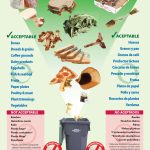Yes, you can compost bread, as it is considered a green composting material due to its high nitrogen content. Bread provides the nutrients necessary for both traditional compost bins and worm compost bins.
However, it is important to note that bread may attract rodents and other pests, so it should be buried in the middle of the compost pile and covered with dry leaves, sawdust, shredded paper, soil, or manure. The process of decomposition is already underway in moldy bread, making it an even better candidate for composting and speeding up the composting process.
Is Bread Compostable?
| Bread Compostable? | Debunking Myths: There are myths revolving around whether bread can be composted. Let’s clear that up! Bread, even moldy bread, can be composted and it is considered a green composting material due to its high nitrogen content. |
| Understanding the Composting Process | Composting bread is beneficial and speeds up the process due to the decomposition already initiated by mold. Although it’s essential to avoid attracting animals, burying bread in the middle of the compost heap and covering it with “Browns,” such as dry leaves and shredded paper, can prevent pest attraction. |
| Types of Compostable Bread | Stale or moldy bread serves as excellent candidates for composting. However, it’s crucial to avoid adding fatty foods, meat, dairy products, or bones to the compost pile as they do not decompose easily and may attract animals. |
Best Practices For Composting Bread
Can You Put Bread in the Compost?
Bread, despite its (usually) brown color, is considered a green composting material. This is due to their high nitrogen content. It provides the nutrients needed for either a traditional compost bin or a worm compost bin. Stale, out-of-date bread is a good candidate for composting. Even better is moldy bread. The mold indicates that the process of decomposition has already begun, so adding it to the compost pile can speed up the composting process.
When composting bread, it is recommended to use an enclosed bin. This helps contain any odors or potential attractants for animals. When adding bread to the pile, make sure to dig down into the center of the pile. This helps to bury the bread and minimize any potential issues with rodents or pests. Additionally, consider covering the bread with a layer of “Browns” such as dry leaves, sawdust, or shredded paper.
By following these best practices, you can safely compost bread without attracting animals or causing any issues with your compost pile.
Can You Compost Moldy Bread?
Moldy bread can be composted as it contains high nitrogen content, aiding in decomposition. Adding bread to the compost pile can speed up the process as mold indicates decomposition has begun. Ensure proper layering to avoid attracting pests while composting bread.
| Composting moldy bread is beneficial for speeding up the composting process. Adding moldy bread to your compost pile can provide essential nutrients for decomposition. |
| Stale or moldy bread can be considered a green composting material due to its high nitrogen content. It is recommended to bury the moldy bread in the center of the compost pile and cover it with browns like dry leaves or shredded paper. |

Credit: maltalibraries.overdrive.com
What Foods Should Not Go Into Compost?
Composting is a great way to reduce waste and nourish your garden, but not all foods are suitable for the compost bin. Avoid putting bread, meat, dairy, or fatty foods in your compost to prevent attracting animals. Non-compostable foods can slow down the decomposition process and create unpleasant smells. To keep your compost healthy and efficient, stick to fruits, vegetables, eggshells, and yard waste. Properly managing your compost can help minimize odors and maintain a balanced environment for beneficial organisms.
Adding Bread To The Compost Pile
Adding Bread to the Compost Pile: When composting, it is important to consider beneficial composting practices such as layering techniques and different compost setups. Bread, despite its brown color, is considered a green composting material due to its high nitrogen content, providing the necessary nutrients for composting. Moldy bread can be even better for composting as it indicates the start of decomposition, speeding up the process. However, it is important to be cautious when adding bread to the compost pile as it may attract rodents and pests. To mitigate this, it is recommended to bury the bread in the center of the compost bin or heap and cover it with a layer of “Browns” like dry leaves, sawdust, or shredded paper.
What Cannot be Composted: It is important to avoid adding fish, meat, dairy products, bones, baked goods, fatty foods, or greases to your compost pile as these items do not easily decompose and may attract animals. Similarly, diseased plants or plants toxic to other plants should not be used for composting.
Composting Bucket Contents: Bread, rolls, bagels, and muffins can be added to the compost pile along with brown paper towels and napkins (from break rooms only, not white towels).

Credit: www.nytimes.com
Community Insights On Composting Bread
Community members share diverse insights on composting bread. While bread adds nitrogen to compost, burying it in the center of the pile with layers of browns like dry leaves can prevent pest attraction. Cold composting bread alongside soil or manure has also proven successful in reducing waste.
| Community Insights on Composting Bread |
|---|
|

Credit: discover.texasrealfood.com
Frequently Asked Questions On Can You Put Bread In The Compost
Is It Ok To Compost Bread?
Yes, you can compost bread. Bread is a green composting material due to its high nitrogen content, making it suitable for traditional compost bins or worm compost bins. Moldy bread is even better for composting as the mold indicates decomposition has already begun, speeding up the composting process.
However, be cautious as bread may attract pests, so bury it in the middle of the bin or heap and cover with “Browns” like dry leaves or shredded paper, followed by a layer of soil or manure.
Can You Throw Moldy Bread In Compost?
Yes, you can compost moldy bread as it speeds up the decomposition process, providing nutrients for the compost pile.
What Food Cannot Be Composted?
Bread, meat, dairy, bones, and fatty foods should not be composted as they do not easily decompose and may attract animals. Avoid diseased plants and plants toxic to others.
Can You Put Bagels In Compost?
Yes, you can put bagels in compost. Bagels, along with bread, rolls, and muffins, can be composted. However, it is important to bury them in the middle of the compost bin or heap and cover them with a layer of “Browns,” such as dry leaves or shredded paper, to avoid attracting rodents and pests.
Conclusion
Composting bread is absolutely possible and beneficial for your compost setup. Despite its brown color, bread is considered a green composting material due to its high nitrogen content. Whether you’re using a traditional compost bin or a worm compost bin, bread provides the necessary nutrients for decomposition.
Additionally, moldy bread can actually speed up the composting process, making it an even better candidate for your compost pile. So go ahead and include bread in your compost, just be sure to bury it in the middle of the bin and cover it with a layer of “Browns” like dry leaves or shredded paper to avoid attracting pests.
Happy composting!

I am a graduate of Bangladesh Agricultural University, where I delved into various agricultural disciplines, equipping me with a profound understanding of agriculture. Beyond academics, I have hands-on experience in gardening and crop cultivation. My passion is to embrace sustainable farming and horticulture. With a BSc in Agriculture, I am dedicated to promoting environmentally conscious and efficient agrarian practices.
Bachelor of Science (BSc) in Agriculture (Hons.)
Master of Science. (Sustainable Agriculture & Food Security ) (MS)
Bangladesh Agricultural University



